Portions of a generic genetic-algorithms library
Introduction
Over the last few months I have become interested in problems associated with modelling non-linear systems. This interest has lead me to look into artificial neural networks, and how they can be trained using genetic algorithms. For those with an interest in this area, development environments like Matlab provide an ideal platform for quick implementation and testing [1]. However, at deployment time, a Matlab script is of little use to clients with a limited budget [2], or to developers targeting embedded platforms, or non-x86 and non-SPARC architectures [3].
Genetic Algorithms for Dummies
Disclaimer about how much I actually know about genetic algorithms. [Damn it Jim I'm a software engineer, not an AI specialist!]
Intent
The intention of this project is to provide a framework that is capable of mimicking the back-end behaviour of the Matlab genetic algorithms library. The framework should allow a client to adapt and extend the framework to suit their specific needs. The framework should:
- Allow optimizing of client defined types
- Allow client defined selection, reproduction, and mutation strategies
- Provide the easy removal of unused strategies for the purposes of reducing the size of the final distributable
Design Themes
Throughout the design, an attempt has been made to maintain several design themes. These are perhaps more out of style then necessity. In fact, for this particular application, some of these choices may be to the detriment of performance.
Themes of Note
The themes of note are:
- Object level encapsulation (see Encapsulation boundary for a discussion on this):
- Where an objects children must cross its boundary, clones are made. This is to avoid any side effects due client types retaining references to the parent objects internals, and modifying the parent objects internals unexpectedly.
- A YAGNI approach is applied to class interfaces:
- Obey the Law of Demeter.
- Recursion introduction
Of course, as with all good rule sets, these are at times broken; especially where the consequences of breaking these rules is insignificant.
Criticisms
I view pursuing object level encapsulation is an honourable thing; however, the performance hit due to copying every single gene of an entire generation is likely to be significant. While this particular situation does occur in this design, I believe in hindsight, that this may have been a bad idea. A future iteration of this design will likely remove this portion of the design, although some empirical evidence should be gathered to support this refactoring.
Modelling the Data
During a genetic algorithm run, candidate solutions are stored and manipulated. The fittest solutions are persisted across the generations. To this end, a structure for storing and manipulating candidate solutions is required. Candidate solutions are grouped by generation. For any given genetic algorithm run, there may be a set of generations. For the purposes of migration, this set should be ordered. Within each generation is a set candidate solutions, each solution is described by genetic material which may be truncated, split, and interleaved with another candidate's genetic material during reproduction. Genetic material may also be subject to arithmetic operations during reproduction and mutation. Each candidate solution stores the fitness of its genetic material. Given this information, the model described in Fig. <insert figure number here!> was constructed. This model separates these concerns as per Table <insert table number here!>.
| Class | Description | Responsibilities |
|---|---|---|
| GenerationSet | A set of generations | To hold an ordered collection of generations. To host migration activities. |
| Generation | A single generation | To hold a collection of candidate solutions. To host reproduction activities. |
| Candidate | A candidate solution | To hold an ordered collection of genetic components. To host mutation activities. To host fitness calculations. To facilitate arithmetic operations on genetic material. |
| IGene | A component of a candidate's genetic material | To define an interface for arithmetic operations on a user defined gene type. |
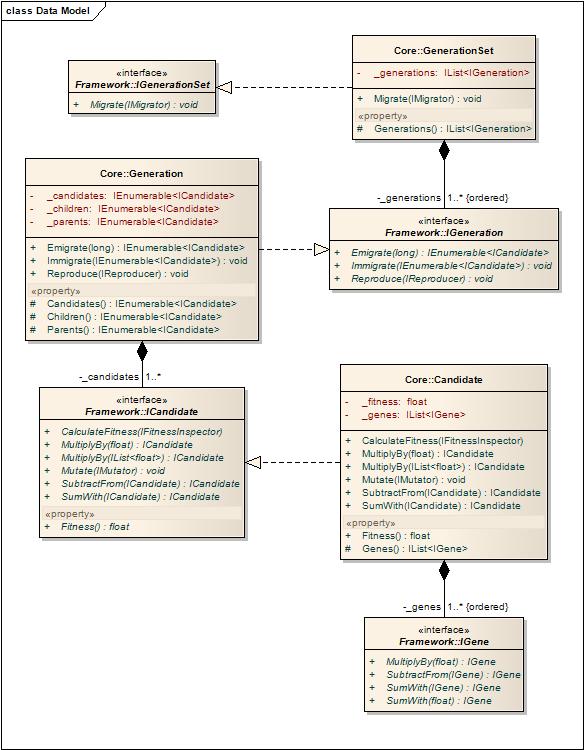
Candidate Creation
Structure
A major goal of the framework is to provide the ability to optimise client defined types. The client should be able to extend the framework to define a candidate's genes, and the process by which these are created. To facilitate this, the framework should define a contract by which the framework can work, and from which the client can inherit or realise. This is design by contract. This contract should define abstract entities that include:
- A candidate
- A candidate's genes (an ordered collection of chromosomes)
- A class responsible for candidate creation
- A class responsible for gene creation
Here we have a nested pair of abstract classes responsible for the creation of a nested pair of abstract products. This is the contractual portion of a factory method. The framework defines the concrete candidate product, while the client is left to implement the concrete chromosome product.
Further to this, the framework should provide the ability to define the size of each generation, and the number of parallel generations in any given run of a genetic algorithm. As per the candidate and its genes, the framework should provide the contractual portion of:
- A generation
- A class responsible for generation creation
The final result is two parallel sets of nested abstract classes; one of abstract products, the other of abstract creators. The structure of which forms a triply nested factory method (Fig. <insert figure number here!>). Table <insert table number here!> describes the roles of each of these classes.

| Participant | Role | |
|---|---|---|
| IGeneration factory: | Generation | Concrete Product |
| Creator | IGenerationCreator | |
| GenerationCreator | Concrete Creator | |
| + Build() : void | Factory Method | |
| ICandidate factory: | Candidate | Concrete Product |
| ICandidateCreator | Creator | |
| CandidateCreator | Concrete Creator | |
| + Build() : void | Factory Method | |
| IGene factory: | To be implemented by the client | Concrete Product |
| IGeneCreator | Creator | |
| To be implemented by the client | Concrete Creator | |
| + Build() : void | Factory Method |
Use
To build the initial genetic algorithm data set, the client must first design and implement the IGene and IGeneCreator interfaces. Having done this, the client must then build the nested creators, and pass these to the GenerationSet constructor. Here, the nested creators will be activated, executing each of the nested Build() methods in a recursion introduction like flow. The result is a fully initialized IGenerationSet. The following example demonstrates how a client might define genetic material and a set of generations in the C# language.
IList<IGeneCreator> geneCreators = new List<IGeneCreator>(); geneCreators.Add(new ClientDefinedGeneCreatorTypeA()); geneCreators.Add(new ClientDefinedGeneCreatorTypeB()); geneCreators.Add(new ClientDefinedGeneCreatorTypeA()); geneCreators.Add(new ClientDefinedGeneCreatorTypeC()); IList<IGenerationCreator> generationCreators = new List<GenerationCreators>(); generationCreators.Add(new GenerationCreator(1024, new CandidateCreator(geneCreators))); generationCreators.Add(new GenerationCreator(512, new CandidateCreator(geneCreators))); generationCreators.Add(new GenerationCreator(256, new CandidateCreator(geneCreators))); //In the execution of this constructor, the nested creators will be activated. IGenerationSet generationSet = new GenerationSet(generationCreator);
Criticisms
Leaving the creation of concrete chromosomes entirely up to the client was perhaps not the best approach. There are some fundamental types of chromosome that could be defined within the framework, and extended by the client. These include value-types like byte, float, integer, double, etcetera.
Calculating Fitness
Having provided the client with the ability to define candidates, the client should also be able to assess the fitness of these candidates. As the fitness of a candidate is completely dependent on the context of the application, the framework can have no knowledge of how this is calculated. As with candidate creation, the fitness calculation will be defined using a contract in the form of an interface. The framework will define its work in terms of this interface, the client can realise this interface.
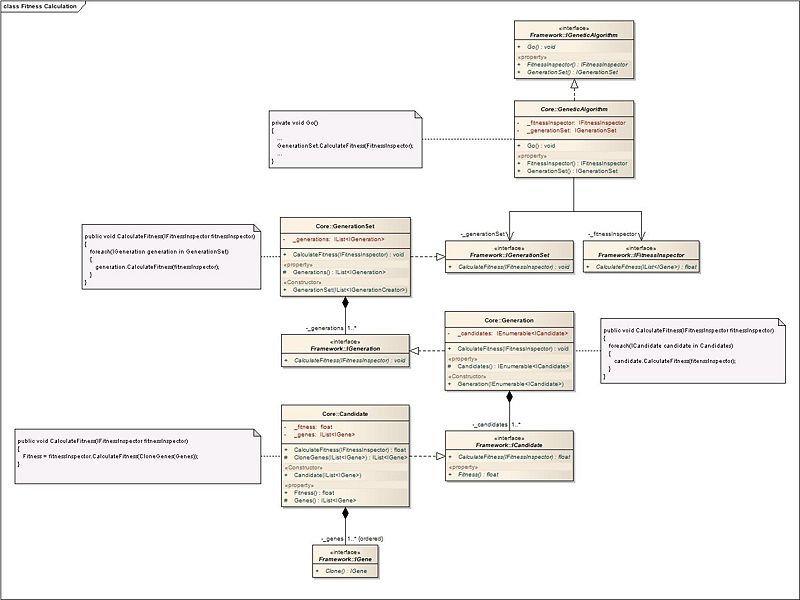
A Fitness Calculation Strategy
Fitness calculations are structured in a strategy pattern as per Table <insert table number here!>. Here, the client is responsible for designing and implementing the concrete strategies.
| Participant | Role |
|---|---|
| GeneticAlgorithm | Context |
| IFitnessInspector | Strategy |
| + CalculateFitness(IList<IGene>) : float | Algorithm Interface |
| Defined by the client | Concrete Strategy |
Instigating Fitness Calculations via Recursion Introduction
When instigating a fitness calculation, a recursion introduction pattern is used. To facilitate this, a
+ CalculateFitness(IFitnessInspector) : void
method is provided on each relevant data model object's interface. The call begins at
+ IGeneticAlgorithm.Go() : void
with a call to
+ IGenerationSet.CalculateFitness(IFitnessInspector) : void
and descends the class hierarchy until reaching the
+ ICandidate.CalculateFitness(IFitnessInspector) : void
method. The execution of this method calls the IFitnessInspector to work on the calling ICandidate's genes.
Candidate Migration
When multiple generations are evolved in parallel, the genetic algorithm may migrate candidates between these generations. The fittest candidates are copied from one generation, and are used to replace the least fit in another generation. The Matlab genetic algorithms libraries allow this to be performed in one of two ways.
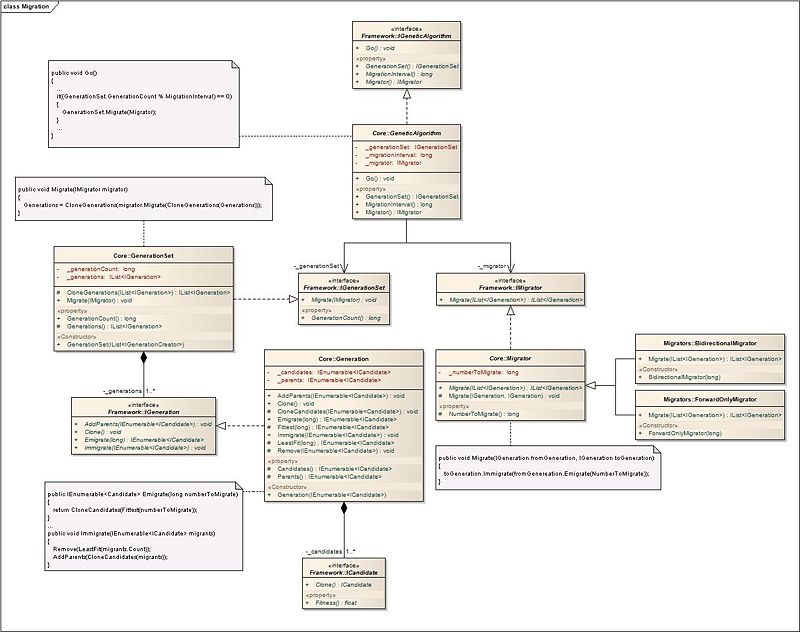
A Migration Strategy
The elements responsible for candidate migration are structured in a strategy pattern as per Table <insert table number here!>. Here, the client is responsible for choosing the strategy; either one defined within the framework, or one of their own design.
| Participant | Role |
|---|---|
| GeneticAlgorithm | Context |
| IMigrator | Strategy |
| + Migrate(IList<IGeneration>) : IList<IGeneration> | Algorithm Interface |
| BidirectionalMigrator | Concrete Strategy |
| ForwardOnlyMigrator | Concrete Strategy |
Selecting the Fittest
Once the fitness of all candidates has been assessed, the candidates that will live on to the next generation are selected. There are many methods by which candidates can be selected. The selection methods presented in the Matlab genetic algorithms library should be reproduced here. The framework should also allow for client defined selection methods.
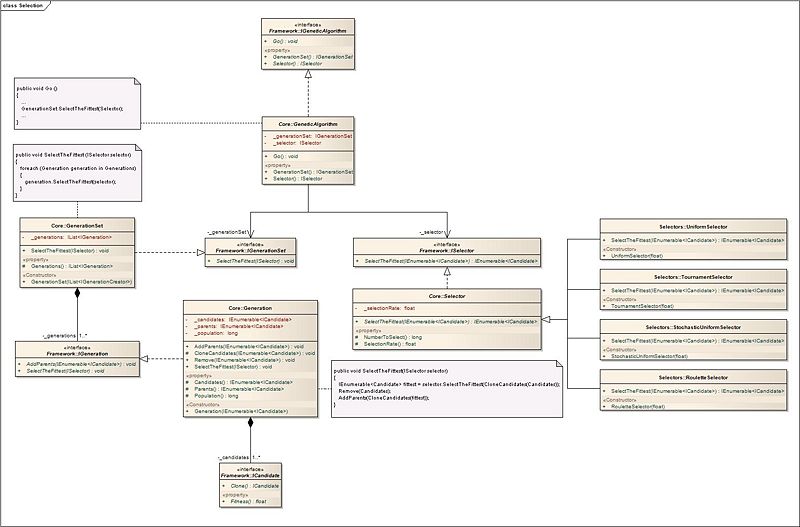
A Selection Strategy
| Participant | Role |
|---|---|
| GeneticAlgorithm | Context |
| ISelector | Strategy |
| + SelectTheFittest(IEnumerable<ICandidate>) : IEnumerable<ICandidate> | Algorithm Interface |
| UniformSelector | Concrete Strategy |
| TournamentSelector | Concrete Strategy |
| StochasticUniformSelector | Concrete Strategy |
| RouletteSelector | Concrete Strategy |
Instigating Selection via Recursion Introduction
When instigating candidate selection, a recursion introduction pattern is used. To facilitate this, a
+ SelectTheFittest(ISelector) : void
method is provided on the each relevant data model object's interface. The call begins at
+ IGeneticAlgorithm.Go() : void
with a call to
+ IGenerationSet.SelectTheFittest(ISelector) : void
which in-turn calls the
+ IGeneration.SelectTheFittest(ISelector) : void
method. The execution of this method calls the ISelector to work on the calling IGeneration's candidates.
Creating Candidates via Reproduction
With the fittest candidates in-hand, the genetic algorithm must go on to combine the DNA of these candidates to create new ones. This reproduction process populates the next generation. As with the selection process, the Matlab genetic algorithm libraries provide several possible ways in which to create new candidates via reproduction. The framework should mimick these, and also allow for client defined reprodution strategies.

A Reproduction Strategy
| Participant | Role |
|---|---|
| GeneticAlgorithm | Context |
| IReproducer | Strategy |
| + Reproduce(ICandidate, ICandidate) : ICandidate | Algorithm Interface |
| ScatterCrossover | Concrete Strategy |
| SinglePointCrossover | Concrete Strategy |
| TwoPointCrossover | Concrete Strategy |
| IntermediateCrossover | Concrete Strategy |
| HeuristicCrossover | Concrete Strategy |
| ArithmeticCrossover | Concrete Strategy |
Instigating Reproduction via Recursion Introduction
When instigating reproduction, a recursion introduction pattern is used. To facilitate this, a
+ Reproduce(IReproducer) : void
method is provided on the each relevant data model object's interface. The call begins at
+ IGeneticAlgorithm.Go() : void
with a call to
+ IGenerationSet.Reproduce(IReproducer) : void
which in-turn calls the
+ IGeneration.Reproduce(IReproducer) : void
method. The execution of this method calls the IReproducer to work on selected pairs of the calling IGeneration's candidates.
Mutating Candidates
Following reproduction, the genetic algorithm must mutate some proportion of the population. As with the reproduction and selection processes, the Matlab genetic algorithm libraries describe several ways in which candidates may be mutated. The framework should reproduce these, and also allow for client defined mutation strategies.

A Candidate Mutation Strategy
| Participant | Role |
|---|---|
| GeneticAlgorithm | Context |
| IMutator | Strategy |
| + Mutate(IList<IGene>) : IList<IGene> | Algorithm Interface |
| GaussianMutator | Concrete Strategy |
| AdaptiveMutator | Concrete Strategy |
Instigating Candidate Mutation via Recursion Introduction
When instigating candidate mutation, a recursion introduction pattern is used. To facilitate this, a
+ Mutate(IMutator) : void
method is provided on the each relevant data model object's interface. The call begins at
+ IGeneticAlgorithm.Go() : void
with a call to
+ IGenerationSet.Mutate(IMutator) : void
and descends the hierarchy until reaching the
+ ICandidate.Reproduce(IReproducer) : void
method. The execution of this method calls the IMutator to work on the calling ICandidate's genes.
Stopping Conditions
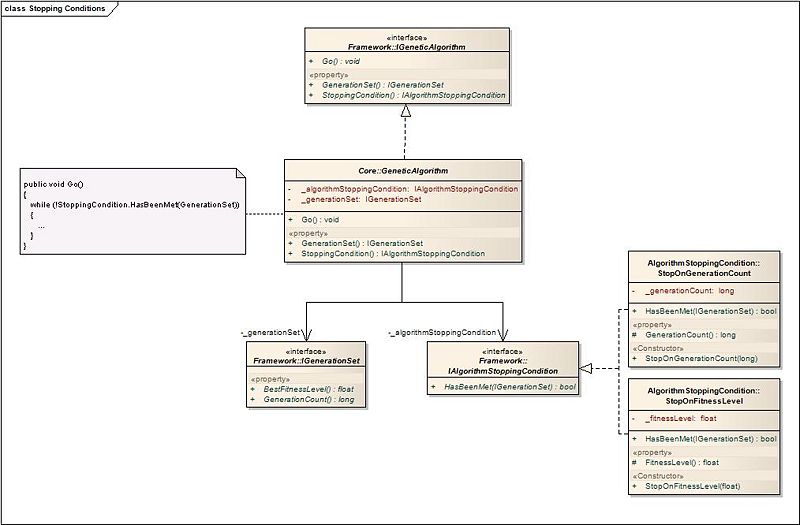
An Algorithm Stopping Strategy
| Participant | Role |
|---|---|
| GeneticAlgorithm | Context |
| IAlgorithmStoppingCondition | Strategy |
| + HasBeenMet(IGenerationSet) : bool | Algorithm Interface |
| StopOnGenerationCount | Concrete Strategy |
| StopOnFitnessLevel | Concrete Strategy |
The Whole Shebang
References
- ^ http://www.mathworks.com/access/helpdesk/help/toolbox/gads/
- ^ http://www.mathworks.com/products/matlab/pricing_licensing.html?tab=com
- ^ http://www.mathworks.com/products/matlab/requirements.html